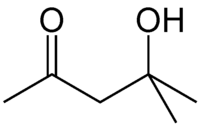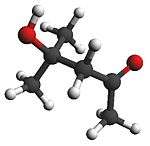Diacetone alcohol
Diacetone alcohol is an organic compound with the formula CH3C(O)CH2C(OH)(CH3)2, sometimes called DAA. This colorless liquid is a common synthetic intermediate used for the preparation of other compounds, and is also used as a solvent.[3]
 | |
 | |
| Names | |
|---|---|
| IUPAC name
4-Hydroxy-4-methylpentan-2-one | |
| Other names
4-Hydroxy-4-methyl-2-pentanone; 4-Hydroxy-2-keto-4-methylpentane; Diacetone alcohol | |
| Identifiers | |
3D model (JSmol) |
|
| 1740440 | |
| ChEBI | |
| ChemSpider | |
| ECHA InfoCard | 100.004.207 |
| EC Number |
|
PubChem CID |
|
| RTECS number |
|
| UNII | |
| UN number | 1148 |
CompTox Dashboard (EPA) |
|
| |
| |
| Properties | |
| C6H12O2 | |
| Molar mass | 116.160 g·mol−1 |
| Appearance | Colorless liquid |
| Odor | Odorless |
| Density | 0.938 g/cm3 |
| Melting point | −47 °C (−53 °F; 226 K) |
| Boiling point | 166 °C (331 °F; 439 K) |
| moderate | |
| Solubility | most organic solvents |
Refractive index (nD) |
1.4235 |
| Hazards | |
| Main hazards | Flammable |
| GHS pictograms |   |
| GHS Signal word | Warning |
GHS hazard statements |
H226, H319, H335 |
| P210, P233, P240, P241, P242, P243, P261, P264, P271, P280, P303+361+353, P304+340, P305+351+338, P312, P337+313, P370+378, P403+233, P403+235, P405, P501 | |
| Flash point | 52 °C; 125 °F; 325 K |
| Explosive limits | 1.8–6.9%[1] |
| Lethal dose or concentration (LD, LC): | |
LD50 (median dose) |
4000 mg/kg (oral, rat) 4653 mg/kg (oral, rabbit) 3950 mg/kg (oral, mouse)[2] |
| NIOSH (US health exposure limits): | |
PEL (Permissible) |
TWA 50 ppm (240 mg/m3)[1] |
| Related compounds | |
Related compounds |
Acetone methyl isobutyl ketone |
Except where otherwise noted, data are given for materials in their standard state (at 25 °C [77 °F], 100 kPa). | |
| Infobox references | |
Synthesis and reactions
First identified by Heintz,[4] one standard laboratory preparation of DAA entails the Ba(OH)2-catalyzed condensation of two molecules of acetone.[5]
It undergoes dehydration to give the α,β-unsaturated ketone, mesityl oxide:[6] Hydrogenation of mesityl oxide gives the industrial solvent, methyl isobutyl ketone ("MIBK"). Hydrogenation gives hexylene glycol. Condensation with urea give diacetone-monourea.
Uses
Diacetone alcohol is used in cellulose ester lacquers,[3] particularly of the brushing type, where it produces brilliant gloss and hard film and where its lack of odor is desirable. It is used in lacquer thinners, dopes, wood stains, wood preservatives and printing pastes; in coating compositions for paper and textiles; permanent markers;[7] in making artificial silk and leather; in imitation gold leaf; in celluloid cements; as a preservative for animal tissue; in metal cleaning compounds; in the manufacture of photographic film; and in hydraulic brake fluids, where it is usually mixed with an equal volume of castor oil.
Safety
The LD50 (oral, rats) is 4 g/kg.[3]
References
- "Diacetone alcohol". Immediately Dangerous to Life and Health Concentrations (IDLH). National Institute for Occupational Safety and Health (NIOSH).
- Sifniades, Stylianos; Levy, Alan B. (2000). "Acetone". Ullmann's Encyclopedia of Industrial Chemistry. doi:10.1002/14356007.a01_079. ISBN 3527306730.
- Heintz, Ann. 169, 114 (1873)
- Conant, J. B.; Tuttle, N. (1921). "Diacetone Alcohol". Organic Syntheses. 1: 45. doi:10.15227/orgsyn.001.0045.
- Conant, J. B.; Tuttle, N. (1921). "Mesityl Oxide". Organic Syntheses. 1: 53. doi:10.15227/orgsyn.001.0053.
- MSDS: Sharpie Chisel Tip Permanent Marker - "Household products database" US Department of Health and Human Services
